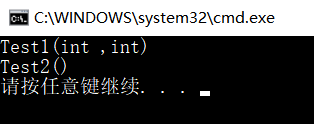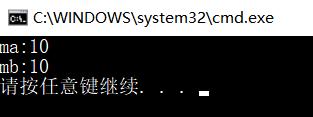定义:
C++中构造函数与其他函数不同的是,除了有名字,参数列表和函数体之外,还可以有初始化列表。
初始化列表以冒号开头,后跟一系列以逗号分隔的初始化字段。
使用原因:
其一 主要是性能问题,对于内置类型,如int, float等,使用初始化类表和在构造函数体内初始化差别不是很大,但是对于类类型来说,最好使用初始化列表,为什么呢?
#include<iostream>
using namespace std;
class Test1
{
public:
Test1() // 无参构造函数
{
cout << "无参构造" << endl;
}
Test1(const Test1& t1) // 拷贝构造函数
{
cout << "拷贝构造" << endl;
this->a = t1.a;
}
Test1& operator = (const Test1& t1) // 赋值运算符的重载函数
{
cout << "赋值运算符" << endl;
this->a = t1.a;
return *this;
}
~Test1()
{
cout << "析构" << endl;
}
int a;
};
class Test2//Test2是个测试类,它以Test1的对象为成员
{
public:
Test1 test1;
Test2(Test1& t1)
{
test1 = t1;//对test1进行赋值
}
};
int main()
{
Test1 t1;
Test2 t2(t1);
return 0;
}
运行结果:

如果使用初始化列表来实现Test2的构造函数
class Test2//Test2是个测试类,它以Test1的对象为成员
{
public:
Test1 test1;
Test2(Test1& t1):test1(t1)
{
}
};
int main()
{
Test1 t1;
Test2 t2(t1);
return 0;
}
运行结果:

从中比较得知:使用初始化列表少了一次调用默认构造函数的过程,直接调用拷贝构造函数初始化test1,省去了调用调用默认构造函数的过程。这个这对于数据密集型的类来说是高效的。
其二 有些时候初始化列表是不可或缺的,以下情况时必须使用初始化列表。
A 当类成员中含有一个const对象时,或者是一个引用时,必须要通过成员初始化列表进行初始化,因为这两种对象要在声明后马上初始化,而在构造函数中,做的是对他们的赋值,这样是不被允许的。
1.常量成员,因为常量只能初始化不能赋值,必须放在初始化列表里面
#include<iostream>
using namespace std;
class Test
{
public:
Test(int a, int b)
{
ma = a;
mb = b;
}
void Show()
{
cout << "ma:" << ma << endl;
cout << "mb:" << mb << endl;
}
private:
int ma;
const int mb;
};
int main()
{
Test test1(10,20);
test1.Show();
return 0;
}
C++中const修饰的成员变量一定要在初始化列表中进行初始化
Test(int a, int b)
{
ma = a;
mb = b;
}
这里相当于
const int mb;
mb=b;//常量不可以修改
解决方法:
Test(int a, int b):mb(b)
{
ma = a;
//mb = b;
}这里相当于
const int mb=b;
打印结果:

2.引用类型,引用必须在定义的时候初始化,并且不能重新赋值,必须写在初始化列表里。
#include<iostream>
using namespace std;
class Test
{
public:
Test(int a, int b)
{
ma = a;
mb = b;
}
void Show()
{
cout << "ma:" << ma << endl;
cout << "mb:" << mb << endl;
}
private:
int ma;
int& mb;
};
int main()
{
Test test1(10, 20);
test1.Show();
return 0;
}
解决方法:
Test(int a, int b):mb(b)
{
ma = a;
//mb = b;
}打印结果:

B 数据成员是对象,并且这个对象只有含参数的构造函数,没有默认构造函数。因为使用初始化列表可以不必调用默认构造函数来初始化,而是直接调用拷贝构造函数初始化。
#include<iostream>
using namespace std;
class Test1
{
public:
Test1(int a, int b)
{
cout << "Test1(int ,int)" << endl;
}
private:
int x;
int y;
};
class Test2
{
public:
Test2()
{
cout << "Test2()" << endl;
}
private:
Test1 test; //声明
};
int main()
{
Test2 t;
return 0;
}

解释:
Test1有显示的带参数的构造函数,则无法依靠编译器生成无参构造函数的,所以没有两个int型数据,就无法创建Test1的对象。Test1类对象是Test2的成员,想要初始化这个对象test,就只能用成员初始化列表,没有其他办法将参数传递给Test类构造函数。
如果有一个类成员,它本身是一个类或者是一个结构,而这个成员它只有一个带参数的构造函数,没有默认构造函数,若要对这个类成员进行初始化,就必须调用这个类成员的带参的构造函数,如果没有初始化列表,那么将无法完成第一步,就会报错。
修改如下:
class Test2
{
public:
Test2():test(1, 2)
{
cout << "Test2()" << endl;
}
private:
Test1 test; //声明
};
int main()
{
Test2 t;
return 0;
}
打印结果:

成员变量顺序:
#include<iostream>
using namespace std;
class Test
{
public:
Test(int a, int b):mb(ma),ma(a)
{
cout << "Test(int ,int)" << endl;
}
void Show()
{
cout << "ma:" << ma << endl;
cout << "mb:" << mb << endl;
}
private:
int ma;
int mb;
};
int main()
{
Test test1(10,20);
test1.Show();
return 0;
}
打印结果:

Test(int a, int b):ma(a),mb(ma)
{
}
private:
int mb;
int ma;
从中可以看出:
初始化列表中的执行顺序只和成员变量的声明顺序有关。